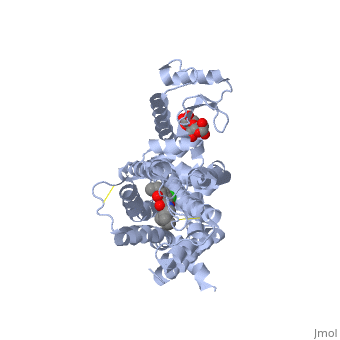User:Jessica Gauldin/Sandbox1
From Proteopedia
(Difference between revisions)
| Line 5: | Line 5: | ||
== Structure == | == Structure == | ||
| + | There are 5 classes of dopamine receptors (D1, D2, D3, D4, D5), all of which have similar structures since they are all part of a G-protein coupled receptor family. This means that the portion of the receptor spanning the inner part of the cell’s membrane is composed of seven membrane-spanning G-protein (guanine nucleotide binding) domains (Beaulieu). | ||
| + | The D1 and D5 dopamine receptors are 80% homologous in their transmembrane domains, whereas the D3 and D4 dopamine receptors are 75 and 53% homologous, respectively, with the D2 receptor (Beaulieu). Meaning, all of the dopamine receptors have similar structures. | ||
| + | |||
| + | Proteins are a long chain of various amino acid sequences. Inside the binding pocket, the residues that are used to bind dopamine to the receptor are Asp-114, Ser-193, Ser-197, Phe-110, Met-117, Cys-118, Phe-164, Phe-189, Val-190, Trp-386, Phe-390, and Hist-394. Dopamine binds to the top of the receptor structure. The pocket formed by these residues is hydrophobic and the residues are consistent among human dopamine receptors (Kalani et al., 2004). In the dopamine receptor, both the N-terminus (amino end of the polypeptide chain) and the C-terminus (carboxyl-group end of the polypeptide chain) are located on the extracellular portions of the cell membrane. Furthermore, all dopamine receptors contain two cysteine amino acids on their extracellular portions whose disulfide bridge helps stabilize this protein (Missale et al., 1998). | ||
== Disease and Relevance == | == Disease and Relevance == | ||
Revision as of 21:19, 16 November 2015
Dopamine Receptor
| |||||||||||
References
- ↑ Hanson, R. M., Prilusky, J., Renjian, Z., Nakane, T. and Sussman, J. L. (2013), JSmol and the Next-Generation Web-Based Representation of 3D Molecular Structure as Applied to Proteopedia. Isr. J. Chem., 53:207-216. doi:http://dx.doi.org/10.1002/ijch.201300024
- ↑ Herraez A. Biomolecules in the computer: Jmol to the rescue. Biochem Mol Biol Educ. 2006 Jul;34(4):255-61. doi: 10.1002/bmb.2006.494034042644. PMID:21638687 doi:10.1002/bmb.2006.494034042644

